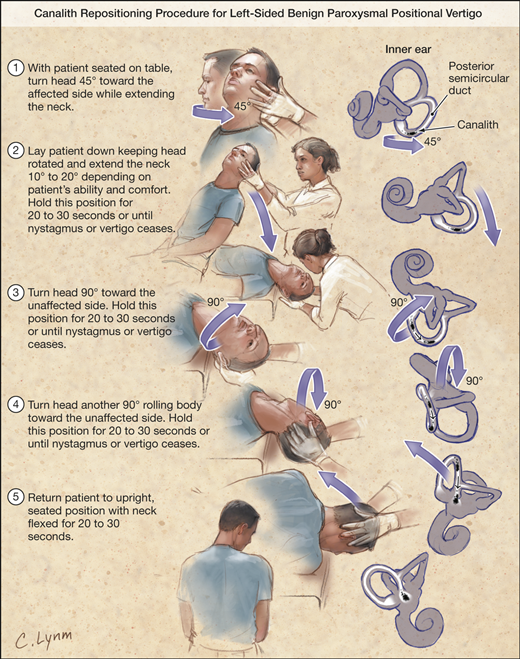

Given that speed of rotation is critical for a successful Semont manoeuvre whereas adequate neck extension and flexibility is required for a successful Epley treatment ( Faldon and Bronstein, 2008), choosing one of them depends on the particular features of the patients, such as weight or neck mobility. Only a small difference was found in the posterior to horizontal canal switch rate between both manoeuvres, being slightly more frequent in Epley manoeuvre than in Semont one ( Anagnostou et al., 2014). The results, measured as the number of manoeuvres required for clearing the symptoms and the nystagmus, are comparable ( Fife et al., 2008, Helminski, 2014, Liu et al., 2016). It has been extensively proved that Epley (1992) ( Fig. 1) and Semont ( Semont et al., 1988) ( Fig. 2) manoeuvres are both suitable for treating pc-BPPV. It is diagnosed when a Dik-Hallpike or a side-lying test elicits a torsional nystagmus with the upper pole of the eyes beating toward the lower ear combined with vertical nystagmus beating upward, that lasts less than a minute and is precluded by a short latency ( von Brevern et al., 2015). Posterior canal canalolithiasis is the most frequent variant of BPPV, accounting for 80–90% of cases. Given that the treatment of choice for BPPV, the repositioning manoeuvres, are intended to move the particles from the semi-circular canals to the utriculus, diagnosis is crucial for the treatment planning.Ģ. Treatment of the posterior canal canalolithiasis (pc-BPPV) A canalolithiasis or a cupulolithiasis will be determined by the latency and the duration of the nystagmus. Thus, cupulolithiasis of the anterior canal has not been considered.ĭiagnosis of BPPV is made by specific test that exposes each canal to gravity, causing a nystagmus that matches the stimulation of the canal. Although BPPV might affect every canal, this document only recognizes the forms that have been documented by eye movements recording. It is based upon physiopathology, considering canalolithiasis and cupololthiasis of every canal as different sub-entities. Recently, the Committee for the Classification of Vestibular Disorders of the Bárány Society has stablished the criteria for the diagnosis of benign paroxysmal positional vertigo ( von Brevern et al., 2015). On the contrary, cupulolithiasis nystagmus has no latency or a brief one and lasts more than a minute. Canalolithiasis nystagmus is brief (lasting less than a minute), paroxysmal and it is preceded by a latency of few seconds. These two variants of BPPV means different characteristics of the nystagmus elicited by the provoking manoeuvres. It has been calculated that a mass of particles of 0,087 ug are required for a canalolithiasis in contrast to cupulolithiasis, that needs a mass of at least 0,69 ug to be provoqued ( House and Honrubia, 2003).


Thus, the cupula is made sensible to linear accelerations, such as the acceleration of gravity.Ĭanalolithiasis are more frequent than cupulolithiasis, as the former needs less mass to be symptomatic. Whereas they are displaced according to the head movements, an endolymphatic current that abnormally stimulates the cupula is generated, leading to clinical symptoms.Ĭupulolithiasis involves a deposit of otolith rests adhered to the cupula of the canal, changing its specific gravity.

#BENIGN POSITIONAL VERTIGO FREE#
There are two accepted theories supporting BPPV, known as canalolithiasis and cupulolithiasis ( Honrubia et al., 1999, House and Honrubia, 2003).Ĭanalolithiaisis refers to the presence of cumulates of otolith rests that are free into the canals. It is characterized by rotational vertigo induced by head position changes, especially when extending or turning the neck, lying down or rolling over in bed. Benign Paroxysmal Positional Vertigo (BPPV) is the most frequent vestibular disorder, with a life time prevalence of 10% ( von Brevern et al., 2007).


 0 kommentar(er)
0 kommentar(er)
